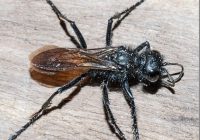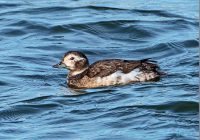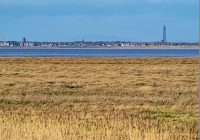Dr Phil Smith’s Wildlife Notes
January 2020
January was remarkably mild with early-morning frost on only three days. It rained on 14 days but most of it was light and patchy, being concentrated in the first half of the month. Accordingly, the water-table rose by 6.5 cm in the first two weeks but fell by 1 cm in the next fortnight. The unseasonal conditions resulted in some remarkable insect sightings. Pete Kinsella emailed on 15th to say that he had found a Green Shieldbug sunning itself on Ivy at Crosby and then as many as six on the 19th. These were the brown hibernation form but should not have been out and about in January. Even more surprising, I was struggling up the steep sandy slope to the Devil’s Hole on 29th when I spotted a familiar shape on the sand. It was a large sand-wasp. Expecting it to be dead, I picked it up only to discover it was still alive, despite having lost its black-and-red abdomen. I took it home and identified it as a Hairy Sand Wasp Podalonia hirsuta, a familiar summer duneland species. Online research confirmed that mated females often over-winter. Perhaps this one ventured out in the mild weather and was attacked by a bird. I hesitate to make false accusations, but there was a perky male Stonechat flying from bush to bush in the Devil’s Hole.
I had a memory of seeing lichens on the older part of Ainsdale Sandhills Local Nature Reserve so I ventured out there on 5th, finding extensive patches of the common Reindeer Moss Cladonia rangiformis but also some of an unfamiliar species, Cladonia foliacea. Although fairly widespread, this has a largely coastal distribution and does not seem have an English name. As I noted in December, the fixed-dunes at Ainsdale are now well-grazed by the winter herd of Redpoll cattle but the older slacks are heavily invaded by scrub, especially Sea Buckthorn and birch. However, one of them near the coast road had two patches of a willow with flame-red stems. I waded out to the nearest clump and, as I suspected it looked like the extremely rare Don’s Willow. There are only about 40 bushes of this hybrid between Creeping and Purple Willow known in Britain, nearly all of them being on the Sefton Coast. I made a mental note to revisit the site in spring and summer to confirm their identity from the catkins and leaves. I also took a small sample of twigs and put them in water. By the end of the month they were producing roots and young leaves, the shape of which looked promising.
News of an American Long-billed Dowitcher at Marshside merited a visit on 17th, though it had already been there about a week. Fortunately, it was a long-stayer on the reclaimed marsh opposite Glencoyne Drive. The only downside was that, while I was there, it was mostly asleep, with its characteristic bill tucked out of sight. The following day, I went down to Crosby Coastal Park to see a more traditional winter visitor, a Long-tailed Duck. It was much more obliging, actively diving for food and coming close enough to photograph on the small boating lake.
A Mistle Thrush was singing loudly as I walked into Freshfield Dune Heath Nature Reserve on one my regular visits. This time I diverted to the so-called Montagu Road triangle, an adjacent area of heathland that was once wall-to-wall Heather but, due to lack of management, now supports 10-20 foot-high pines and birches. Returning to the nature reserve, I spent some time photographing a rich variety of lichens on one of the old “cops” or banks that used to divide the 19th century field system on this former farmland.
Two trips to Marshside and Crossens during the month were quite productive. The first gave good views of a male Hen Harrier flying back and forth across the marsh. This graceful grey raptor is always a thrill to see. The second produced only a Merlin and a distant Marsh Harrier from the usual watch-point, the afternoon light casting a rich glow over the marsh towards the distant Blackpool Tower. I then joined Pete Kinsella and Mark Nightingale who had found three or four Water Pipits on the saltmarsh with no less than 48 Pied Wagtails. The pipits were a bit too far for photographs but, through a telescope, their large size, greyish plumage with white underparts and a white eye-stripe separated them from nearby Meadow Pipits. A Great White Egretwas also showing well a little further away.
The “Buckthorn Bashers” met three times during the month with up to 15 hardy volunteers on each occasion. Beginning eight years ago, these organised groups have cleared invasive Sea Buckthorn from the frontal dunes and slacks north of Shore Road, Ainsdale. Although we are still tackling regrowth, the difference this has made is evident, especially when compared to dunes further north where scrub invasion is a major problem. As we returned from the final “bash” of the month, a Red-tailed Bumblebee was flying over the Ainsdale Discovery Centre, yet another reminder of how our weather is changing.





